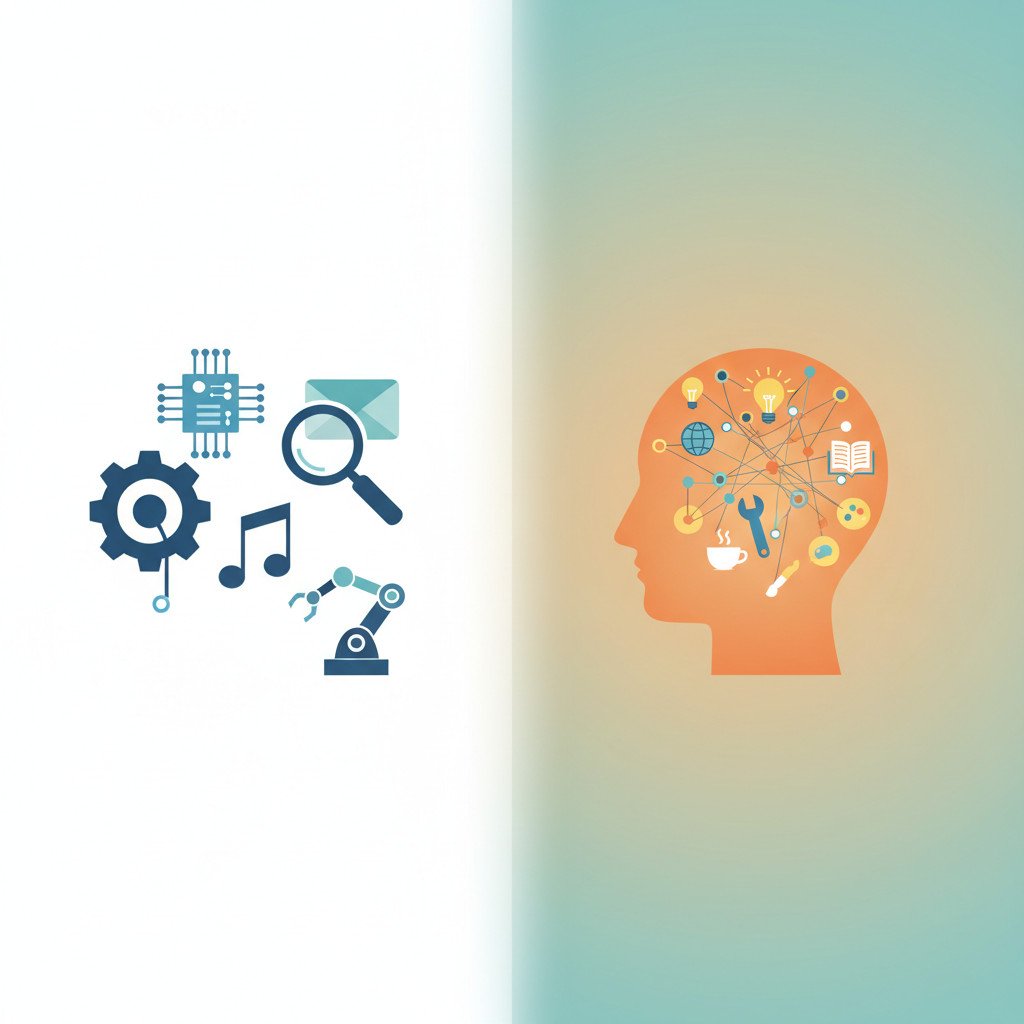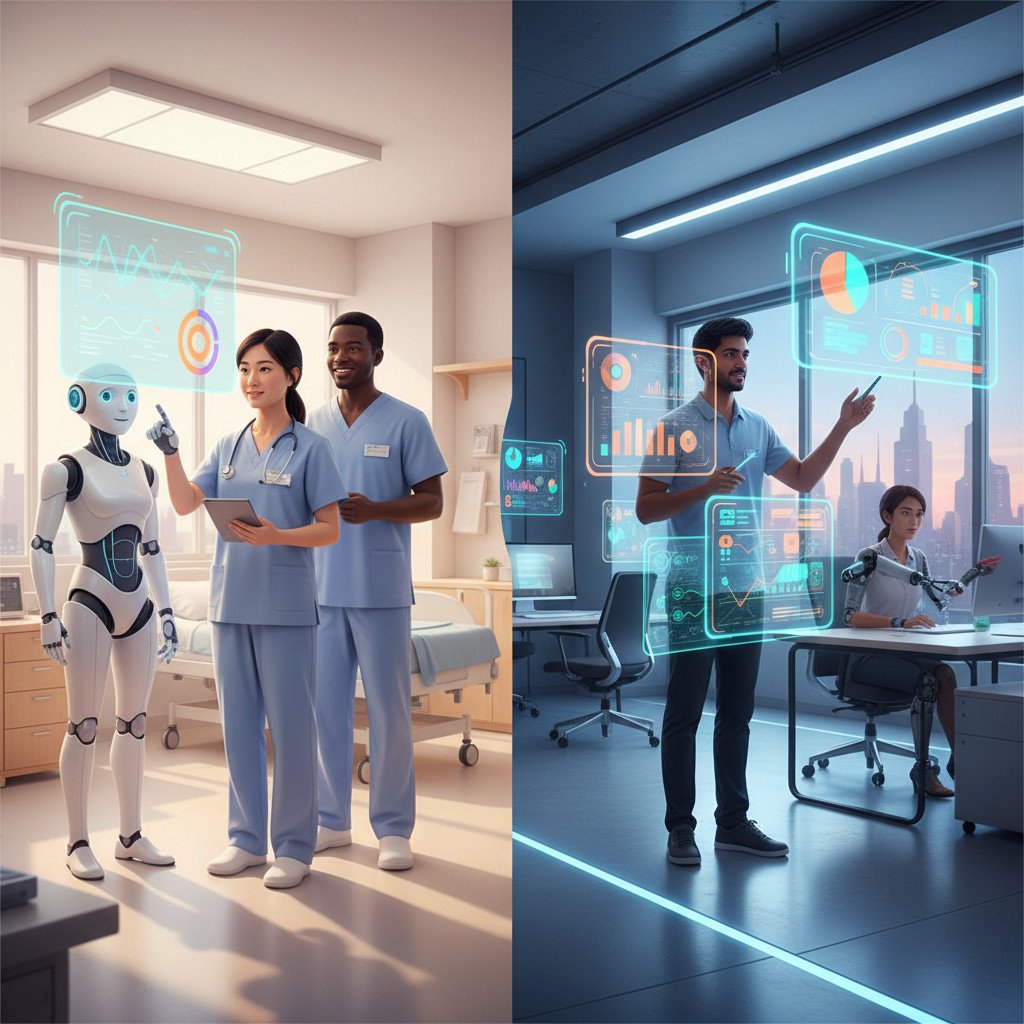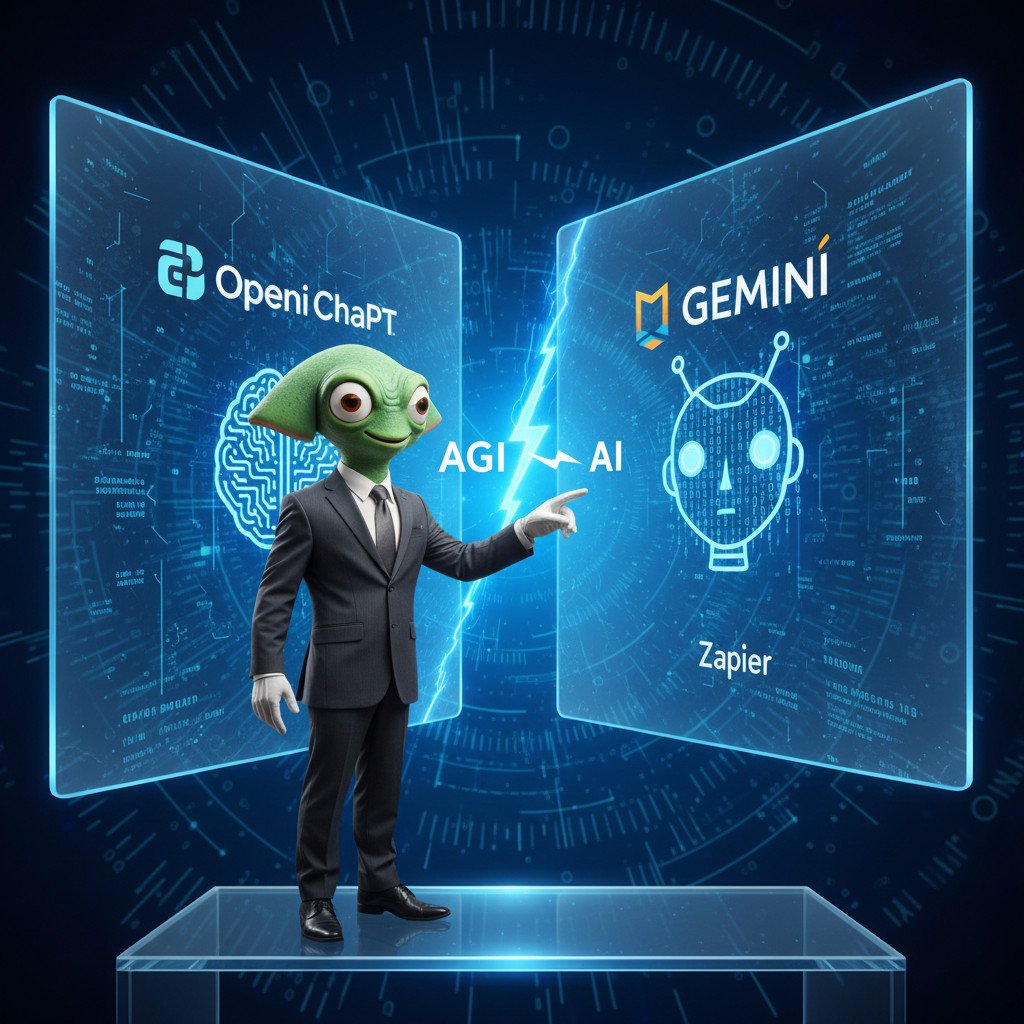AGI vs AI: Why the Distinction Matters Today
Artificial intelligence is reshaping work, media, and daily life. Interest in AGI vs AI is surging because people want to know what comes next. Today we rely on narrow AI to search, draft emails, and recommend shows. However, AGI would do more than one task and could learn across any domain without retraining. For now, AGI remains theoretical and far from reality. Meanwhile, narrow AI powers tools like ChatGPT, Claude, and integrations that run workflows.
As a result, the debate between domain-general intelligence and task-specific systems matters for leaders, developers, and everyday users. Therefore, this article sets up clear definitions, practical examples, and accessible guidance on adoption. We will look at benefits, risks, equity, and who gains when AI becomes more democratic. Because the technology will affect jobs, product strategy, and policy, readers should understand both the hype and the limits. By the end, you will grasp why the AGI vs AI distinction shapes choices about tools, investment, and governance.
AGI vs AI: Clear Definitions
Artificial Intelligence refers to systems that perform specific tasks. These systems learn patterns from data. Narrow AI powers search, email drafting, recommendation engines, and automation. For example, ChatGPT writes text, Claude answers questions (Claude AI), and Zapier runs AI-powered workflows across apps (Zapier).
Artificial General Intelligence would match human flexible understanding. AGI could learn new domains without retraining. In short, AGI remains theoretical and does not exist yet. Steve Wozniak described a true AGI as something that could enter a random kitchen and make coffee. That image shows domain-general problem solving in plain terms.
Key differences at a glance
- Scope
- AI: task-specific and narrow. It excels at defined jobs.
- AGI: domain-general. It adapts across many tasks and contexts.
- Learning and transfer
- AI: requires task-specific training or fine-tuning.
- AGI: would transfer knowledge between domains naturally.
- Examples today
- AI: Large language models, recommendation systems, and automation tools like Zapier (Zapier).
- AGI: hypothetical systems that can reason across any subject.
Why the distinction matters
- Because narrow AI already affects jobs and products, leaders must plan.
- Therefore, strategy differs when you assume AGI is imminent or far off.
- For milestones and investment context, read this analysis on value realization and AGI vs AI: AI Value Realization.
- Meanwhile, consider how enterprise agents could change desks: Gemini Enterprise Desk.
- For strategy and readiness, see this deeper piece: AGI vs AI Strategy.
Related terms: domain-general intelligence, LLMs, narrow AI, superintelligence, AI-powered workflows

A brief history: AGI vs AI and the road so far
The quest for machine intelligence stretches back decades. In 1950 Alan Turing proposed a practical test for intelligent behavior. However, researchers still debated what intelligence meant. Then, in 1956 the Dartmouth conference formalized AI as a field and John McCarthy coined the term artificial intelligence.
Early decades focused on symbolic systems and expert rules. In the late 1950s and 1960s Frank Rosenblatt built the Perceptron. Meanwhile, researchers explored search, logic, and knowledge representation. Because of high expectations, the field hit setbacks in the 1970s and again in the late 1980s during AI winters.
The rise of statistical learning changed the game. In 1986 researchers revived neural networks with backpropagation. Then, in 1997 IBM’s Deep Blue beat world chess champion Garry Kasparov, showing machines could master narrow tasks.
Deep learning sparked a new wave after 2012. AlexNet showed how large neural networks could succeed on ImageNet. As a result, vision and speech systems improved rapidly. In 2014 generative adversarial networks opened creative AI directions. In 2016 DeepMind’s AlphaGo beat a Go champion, further proving specialized systems could solve hard problems.
Transformers arrived in 2017 and changed language modeling. Therefore, large language models scaled quickly and powered tools like ChatGPT by 2022. Today, companies such as OpenAI, DeepMind, Anthropic, and others push the limits of narrow AI. For context on milestones and investment, see this analysis on value realization and AGI vs AI: value realization and AGI vs AI.
The long-term pursuit of AGI remained a separate ambition. Because AGI would require robust, transferable reasoning, it keeps researchers debating goals and timelines. Meanwhile, enterprise adopters explore agents and automation. For examples of how agents could change work, read this piece on desks and enterprise agents: agents in enterprise. For strategy and readiness, consult this deeper guide: AGI vs AI strategy.
In short, AI evolved through cycles of hype and progress. However, AGI remains speculative, even as narrow systems reshape many industries.
AGI vs AI Comparison Table
Below is a quick comparison table that contrasts AGI vs AI across key dimensions. Therefore, use it as a quick reference for strategy, policy, and learning.
| Dimension | AI (Narrow AI) | AGI (Domain-general intelligence) |
|---|---|---|
| Scope | Task-specific, narrow focus | Broad, human-like generality |
| Capability | Excels at defined problems | Would reason across domains |
| Adaptability | Needs retraining or fine-tuning | Would transfer knowledge naturally |
| Application areas | Search, recommendations, LLMs, automation tools, AI-powered workflows | Hypothetical: cross-domain assistance, scientific discovery, adaptive robotics |
| Current development status | Mature and in active deployment | Theoretical; does not exist yet |
| Examples | ChatGPT, Claude, Gemini, Zapier workflows | No verified examples; research aim |
| Training requirement | Task-labeled datasets, supervised and reinforcement learning | Would require unified, multimodal learning and reasoning |
| Transfer learning | Limited; often needs task-specific fine-tuning | Built-in transfer across domains (theoretical) |
| Risk profile | Bias, misuse, job disruption, model brittleness | Unknown scale; systemic risks and governance challenges |
| Timeframe | Immediate to near-term adoption | Long-term, uncertain timelines |
Related terms in this table include narrow AI, domain-general intelligence, LLMs, and AI-powered workflows. Use this as a quick summary when comparing AGI vs AI.
AGI vs AI in practice: Real-world applications of narrow AI today
AI already powers major improvements across industries. In healthcare, machine learning finds patterns in images. Radiology systems flag tumors faster than before. Meanwhile, models analyze genomic data to suggest treatments and speed drug discovery. For trusted overviews, see general AI references on Wikipedia.
In finance, banks use AI for fraud detection and risk scoring. Algorithms monitor transactions in real time and stop suspicious activity. As a result, firms reduce losses and speed customer service. AI also supports algorithmic trading and portfolio optimization.
Marketing and sales rely on personalization engines. Recommendation algorithms tailor product feeds and ad creative. For example, generative models write drafts of copy while A B testing finds top performers. Therefore, marketing teams scale content production and improve conversion.
Customer service uses chatbots and virtual assistants. Tools like ChatGPT handle common queries and route complex tickets. In addition, AI summarises conversations so agents work faster. These systems improve response time and free staff for higher-value tasks. See ChatGPT context here: Wikipedia.
Operations and workflow automation tie tools together. Zapier connects apps and runs multi-step automations. Consequently, teams automate repetitive tasks without custom code. Explore Zapier here: Zapier.
Manufacturing and logistics use predictive maintenance and route optimisation. Sensors feed models that predict failures before breakdowns. As a result, companies cut downtime and lower costs.
Creative fields adopt generative systems for images, audio, and video drafts. Designers and writers use AI to iterate ideas rapidly. However, these tools remain specialised and need human guidance.
How this differs from AGI
- Narrow AI amplifies specific skills in one domain.
- AGI would combine skills across many domains naturally.
For practical strategic planning, review milestones and adoption contexts in this analysis: AI Value Realization Analysis. For enterprise agent impacts and desks, read this piece: Gemini Enterprise Desk. For strategy and readiness, see this guide: AGI vs AI Strategy.

AGI vs AI: Challenges and future prospects
The pursuit of AGI raises hard technical questions. For example, current models lack robust common sense. Moreover, they struggle with long-term planning and causal reasoning. Therefore, building systems that generalize like humans remains an open research problem.
Key technical challenges
- Scalability and compute
- Training larger models demands massive compute and energy. As a result, costs grow quickly and centralize capability.
- Data and generalization
- Models need diverse, high-quality, and representative data. Otherwise they will fail in rare or new situations.
- Transfer learning and reasoning
- Current systems excel at pattern matching but not flexible reasoning. In contrast, AGI would need smooth transfer across domains.
- Interpretability and transparency
- Researchers cannot always explain model decisions. Consequently, people find it hard to trust or verify outcomes.
- Safety and alignment
- Aligning goals with human values proves difficult. Therefore, misaligned objectives could produce harmful behaviours.
- Governance and regulation
- Policymakers lag behind technical change. As a result, weak rules may worsen inequality or misuse.
Ethical and societal concerns
- Bias and fairness
- AI systems can reproduce historical bias, harming groups unfairly. Consequently, fairness checks and audits remain crucial.
- Economic disruption
- Automation may shift jobs, and vulnerable workers could suffer. Therefore, planning for reskilling matters now.
- Concentration of power
- Large firms currently control data and compute. As a result, innovation may centralize instead of democratizing.
Future possibilities and uncertainty
- Incremental advances will improve narrow AI capabilities. Meanwhile, researchers experiment with multimodal and neuro-symbolic methods.
- AGI could enable broad scientific discovery, personalised education, and general-purpose assistants. However, timelines remain uncertain.
- Because progress depends on many factors, predictions vary widely across experts. Some expect breakthroughs soon, while others foresee decades of work.
What to watch next
Research into safety and alignment will shape future adoption. For now, leaders should invest in governance, transparency, and equitable access.
Therefore, societies that combine oversight with broad access gain the most. In short, AGI remains a major goal, but its arrival and impact are far from certain.
AGI vs AI: Key Takeaways
Understanding AGI vs AI helps leaders, builders, and citizens make better choices. Narrow AI solves specific tasks today. It powers search, recommendations, LLMs, and AI-powered workflows. Meanwhile, AGI remains theoretical and would combine learning across many domains. Because narrow AI already changes work, strategy must focus on adoption and equity. For firms, invest in clear use cases and governance now. For example, deploy automation where it reduces risk and increases access. However, plan for bias, power concentration, and job shifts. Therefore, public policy should promote transparency, fair data, and reskilling. In addition, research into safety and alignment should continue. As a result, stakeholders can shape benefits while limiting harms.
Quick summary points
- Definitions: AI refers to narrow systems; AGI means general, human-like intelligence.
- Current state: Narrow AI is in production; AGI does not yet exist.
- Impacts: AI boosts efficiency, creativity, and scale; AGI would change many systems.
- What to do: Pilot responsibly, invest in skills, and support fair regulation.
In short, grasping AGI vs AI clarifies trade offs. It helps organisations balance innovation with responsibility.
Conclusion: EMP0 — Full-stack AI for revenue growth
Employee Number Zero LLC (EMP0) builds AI and automation solutions for sales and marketing. We design brand-trained AI workers that learn your voice and systems. As a result, teams scale outreach and nurture without losing brand control. EMP0 bundles full-stack services with proprietary tools:
- Content Engine — generates on-brand content at scale
- Marketing Funnel — maps and automates lead journeys
- Sales Automation — sequences outreach and qualification
- Retargeting Bot — recovers visitors and boosts conversions
- Revenue Predictions — forecasts pipeline and guides investment
Because EMP0 deploys models inside client infrastructure, companies keep data private. Therefore, security and compliance stay intact. Moreover, EMP0 integrates with existing stacks using n8n connectors and APIs. For teams, that means faster time to value and measurable growth.
If you want practical automation with governance, EMP0 helps build it. Visit our website to learn more: our website. Read case studies on our blog: our blog. Try our n8n connectors and workflows: n8n connectors. Contact us to discuss a secure, brand-trained AI worker that multiplies revenue.

